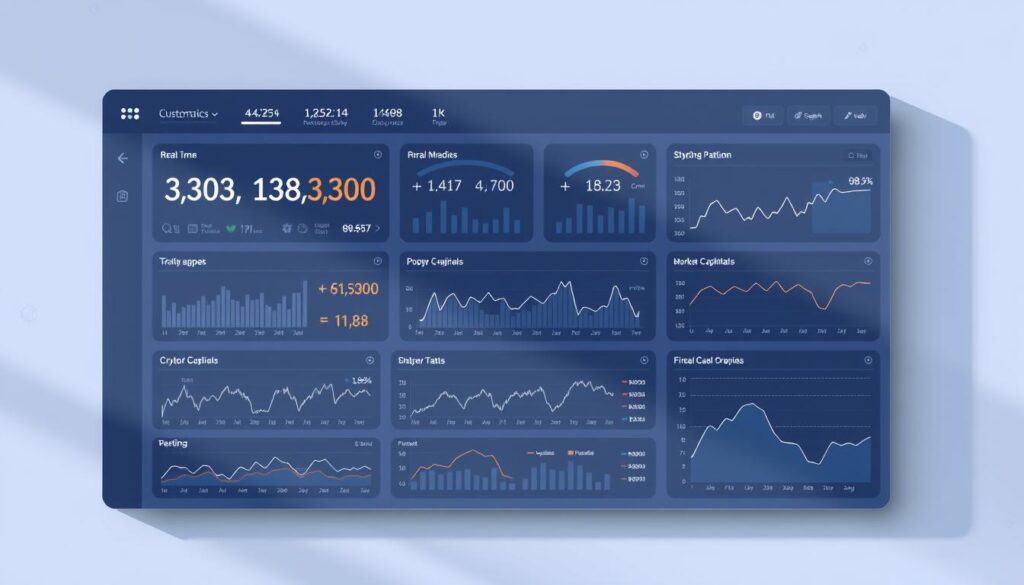The digital asset ecosystem now hosts over 110 specialized platforms delivering actionable insights across blockchain networks. These solutions have evolved far beyond basic price charts, offering institutions predictive modeling, compliance automation, and multi-chain portfolio tracking. Leading providers combine on-chain activity, decentralized finance metrics, and macroeconomic indicators to create decision-ready frameworks.
Platforms like Glassnode exemplify this shift toward institutional-grade analysis, merging real-time transaction data with customizable dashboards. Such systems enable professionals to monitor capital flows across Bitcoin, Ethereum, and emerging protocols while maintaining enterprise-grade security standards. Advanced APIs allow seamless integration with existing infrastructure, supporting large-scale operations.
Modern market intelligence suites address three critical needs: risk quantification across volatile assets, regulatory reporting automation, and strategic position sizing. By aggregating data from wallets, exchanges, and governance protocols, these tools help identify emerging trends before mainstream recognition. Historical pattern recognition further enhances predictive capabilities, aligning with sophisticated investment strategies.
Key Takeaways
- Specialized platforms now exceed 110 options for blockchain network analysis
- Enterprise solutions integrate predictive modeling with compliance features
- Multi-chain monitoring covers Bitcoin, Ethereum, and emerging protocols
- API connectivity enables seamless institutional workflow integration
- Advanced risk scoring models account for volatility and regulatory factors
- Historical pattern recognition enhances strategic decision-making
Product Roundup: crypto analytics tools for institutional investors
Leading financial institutions now leverage specialized platforms combining real-time blockchain metrics with predictive modeling. These systems transform raw network activity into strategic insights, addressing critical needs like risk assessment and compliance automation.
Top Platform Features Reviewed
Nansen excels in wallet behavior tracking across 10+ chains, identifying NFT trends through proprietary labeling systems. Its dashboards reveal hidden correlations between whale movements and market shifts.
Messari Pro delivers institutional-grade research with 90+ technical indicators, from staking yields to governance proposal impacts. Custom alerts notify users about protocol upgrades affecting asset valuations.
Notable Solutions for Advanced Analysis
- Dune Analytics: Enables SQL-based queries across Ethereum and Layer 2 networks
- APY Vision: Calculates impermanent loss thresholds for 500+ DeFi pools
- CoinMetrics: Provides network health scores using 40+ stability metrics
Enterprise platforms prioritize API reliability, with 99.9% uptime guarantees for data feeds. Multi-chain compatibility ensures coverage across Bitcoin, Solana, and emerging ecosystems. Integration capabilities with legacy systems remain crucial for adoption.
Key Capabilities and Technology Behind Leading Platforms
Modern platforms driving blockchain intelligence combine API-driven architectures with advanced data processing frameworks. These systems transform raw network information into structured insights through three core components: real-time connectivity, secure access protocols, and adaptive analytics engines.

Real-Time Monitoring and API Integration
Secure authentication methods like API keys and OAuth tokens form the foundation of enterprise-grade access controls. Platforms employ WebSocket APIs to stream live transaction updates, wallet movements, and liquidity shifts across multiple chains simultaneously.
Rate limiting safeguards ensure stable performance during market volatility. Institutions benefit from:
- GraphQL endpoints for customized data queries
- Webhook configurations triggering instant alerts
- Bulk export functions for regulatory audits
Harnessing On-Chain Data Analytics
Specialized indexing systems process billions of blockchain events daily, identifying patterns in decentralized exchanges and NFT markets. Direct node connections enable platforms like Chainbase to deliver validated transaction histories within 300ms.
Advanced solutions map wallet clusters across 50+ networks while tracking protocol interactions. This granular visibility supports strategic decisions ranging from position sizing to compliance checks. Real-time dashboards highlight emerging trends through visualizations of gas fees, staking yields, and governance participation rates.
Compliance, Security, and Regulatory Reporting in Crypto Analytics Tools
Regulatory frameworks increasingly shape operational strategies across blockchain networks. Modern platforms now integrate compliance protocols directly into their analytics engines, creating automated safeguards against financial risks.
AML Compliance and Risk Scoring
Scorechain leads with customizable risk algorithms assessing wallet activity across 30+ chains. Its system flags suspicious patterns using 150+ behavioral indicators, updating risk scores every 15 seconds. Real-time dashboards show exposure levels through color-coded threat matrices.

Seamless Travel Rule Integration
FATF guidelines require verified originator details for transactions over $1,000. Solutions automatically cross-check VASP registries while validating beneficiary data formats. Automated alerts trigger when transactions lack required identifiers, reducing manual review time by 78%.
Leading systems generate audit-ready reports meeting MiCA standards with one-click exports. Multi-chain monitoring covers ERC-20 tokens, Bitcoin UTXOs, and Cosmos-based assets simultaneously. API connections feed data directly into existing compliance workflows, maintaining operational continuity.
Dedicated support teams assist with jurisdiction-specific updates, ensuring alignment with evolving regulations. This proactive approach helps institutions navigate complex requirements while maintaining portfolio diversity across emerging networks.
User Experience and Interface: Dashboards and Data Visualizations

Modern portfolio management demands interfaces that transform raw metrics into strategic clarity. Leading systems now prioritize adaptive design, enabling professional teams to monitor diverse holdings through unified visual frameworks.
Tailored Views for Complex Operations
Nansen Portfolio demonstrates this shift with cross-protocol tracking that consolidates DeFi positions into single-screen overviews. Users adjust widget layouts to emphasize risk metrics or yield comparisons, aligning displays with specific workflow priorities.
No-code builders like DappLooker simplify dashboard creation without coding expertise. Drag-and-drop modules assemble real-time charts tracking wallet balances, liquidity pool returns, and network congestion indicators. Prebuilt templates accelerate deployment across teams.
Critical features for institutional adoption include:
- Multi-chain compatibility across Bitcoin, Ethereum, and Layer 2 networks
- Export-ready reports meeting audit standards
- Role-based access controls for team collaboration
Real-time alert systems notify users of threshold breaches or regulatory updates through integrated webhooks. Merlin’s smart tracking automatically highlights portfolio rebalancing opportunities using customizable triggers.
Visualization tools convert blockchain transactions into heatmaps and flow diagrams. These displays reveal hidden patterns in asset movements, supporting faster decision cycles. Interactive elements let analysts drill into specific protocols or timeframes without leaving the dashboard.
Leveraging Advanced Insights for Smarter Investment Decisions
Cutting-edge platforms now empower decision-makers with predictive models that convert complex data into clear strategies. These systems analyze market patterns, social sentiment, and protocol health to spotlight high-potential opportunities while minimizing exposure.

Actionable Analytics for Strategic Trading
Token Metrics reshapes investment research through machine learning models that process 200+ technical indicators. Its AI identifies undervalued assets by correlating on-chain activity with historical performance patterns. Traders receive real-time alerts when models detect emerging trends across decentralized exchanges.
Platforms like LunarCrush track social engagement across 15+ channels, measuring sentiment shifts around NFTs and digital assets. This social intelligence helps teams anticipate market movements before they appear in price charts. Santiment complements this approach with deep-dive metrics across 2,500+ networks, from whale wallet flows to developer activity.
| Platform | Key Feature | Data Sources | Strategic Use Case |
|---|---|---|---|
| Token Metrics | AI-driven valuation models | Market data + On-chain metrics | Identifying undervalued assets |
| LunarCrush | Social sentiment scoring | Social media + NFT platforms | Early trend detection |
| Santiment | Network health analytics | Wallet activity + Developer metrics | Risk assessment |
DeFi-focused tools now map liquidity pool dynamics across Ethereum and Layer 2 networks. Advanced dashboards compare yield farming returns against impermanent loss risks, enabling data-driven allocation choices. Machine learning algorithms process these metrics to forecast optimal entry/exit points with 85% historical accuracy.
Real-time correlation matrices help teams balance portfolios during market shifts. These systems automatically adjust position sizes based on volatility thresholds and regulatory changes, maintaining compliance while pursuing alpha generation.
Final Thoughts on Building a Future-Ready Crypto Analytics Stack
Constructing resilient infrastructure for blockchain intelligence demands strategic alignment between technical capabilities and institutional priorities. Robust systems prioritize API reliability and HTTPS enforcement while supporting multi-chain data aggregation. This foundation enables real-time monitoring across diverse networks without compromising security standards.
Scalable solutions must adapt to evolving regulations through automated compliance features. Flexible integration with legacy systems ensures seamless workflow adoption while maintaining performance benchmarks. Teams should evaluate providers based on uptime guarantees and responsive support for strategic cryptocurrency allocation strategies.
Future-proof stacks incorporate machine learning pipelines and cross-chain interoperability. These enhancements position institutions to capitalize on emerging DeFi opportunities while managing risk exposure. Prioritizing vendor roadmaps with privacy-focused analytics ensures long-term relevance in shifting markets.
Successful implementation balances immediate operational needs with adaptive frameworks for tomorrow’s challenges. By focusing on verifiable accuracy and enterprise-grade access controls, organizations build decision-making engines capable of navigating blockchain’s evolving landscape.


No comments yet